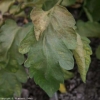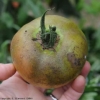Locate and characterize the symptoms
After having defined the agro-cultural and parasitic contexts and carefully chosen the plants most representative of your phytosanitary problem, it is now necessary to better specify the location of the symptoms on the plants and their nature (figure 1).
 |
| Figure 1 |
We have arbitrarily divided them into four parts on which you should focus your observations in order to define the exact nature of the symptoms, and sometimes of the signs present.
- Leaflets and leaves
| Leaf shape abnormality | ||||
|
- Stunted vegetation
- Deformed leaves
(blistered, coiled ...) - Deformed leaves (small, filiform ...) - Leaves with holes
|
 |
 |
 |
 |
| Leaf coloring anomaly | ||||
| - Mosaic leaves - Chlorinated leaves - Other discolorations (tanned, silver ...) |
 |
 |
 |
 |
| Spots on leaves | ||||
| - Small brown spots necrotic - Extensive brown spots - Chlorotic yellow spots - Powdery spots, sporulations ... |
 |
 |
 |
 |
| Leaf wilting, drying out and necrosis | ||||
 |
 |
 |
 |
|
- Roots and crown
| Yellowing, browning, blackening of roots |
||||
 |
 |
 |
||
| Other alterations, root abnormalities |
||||
 |
 |
 |
||
| Various alterations of the neck |
||||
 |
 |
 |
||
- The rod (external or internal)
| Cankers on stem |
||||
 |
 |
 |
||
| Other alterations on the stem (browning, bursting, etc.) |
||||
 |
 |
 |
||
| Alterations of the vessels and / or the spinal cord |
||||
 |
 |
 |
||
- The fruits
| Fruit shape abnormalities |
||||
 |
 |
 |
||
| Fruit color abnormalities |
||||
 |
 |
 |
||
| Fruit spots |
||||
| - Rather limited stains - Localized stains (scars ...) - Extensive stains (rots) - Ring spots |
||||





